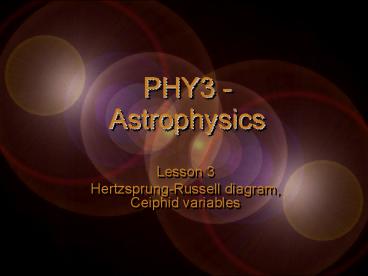PHY3 Astrophysics - PowerPoint PPT Presentation
1 / 14
Title:
PHY3 Astrophysics
Description:
An intrinsic property is one that does not depend on the distance the star is ... apparent magnitude it would have if it were a distance of 10 parsec from Earth. ... – PowerPoint PPT presentation
Number of Views:23
Avg rating:3.0/5.0
Title: PHY3 Astrophysics
1
PHY3 - Astrophysics
- Lesson 3
- Hertzsprung-Russell diagram, Ceiphid variables
2
Hertzsprung-Russell Diagram
- Astronomers looked for correlations between
stellar properties. - Make plots of one intrinsic property vs. another
intrinsic property. - An intrinsic property is one that does not depend
on the distance the star is from the Earth (e.g.,
temperature, mass, diameter, composition, and
luminosity). - By the beginning of the 20th century, astronomers
understood how to measure these intrinsic
properties.
3
Hertzsprung-Russell Diagram
- In 1912, two astronomers, Ejnar Hertzsprung
(1873-1967) and Henry Norris Russell (1877-1957),
independently found a surprising correlation
between temperature (colour) and luminosity
(absolute magnitude) for 90 of the stars. - These stars lie along a narrow diagonal band in
the diagram called the main sequence. - This plot of luminosity vs. temperature is called
the Hertzsprung-Russell diagram or just H-R
diagram for short.
4
- This H-R diagram has plotted luminosity in units
of the Suns luminosity (Lsun 3.9 x 1026 W). - Note that more luminous stars are also more
massive.
5
Mass and luminosity
- Luminosity is roughly proportional to mass raised
to the power of 3.5.
6
Life on the Main Sequence
- Stars on the Main Sequence are burning hydrogen
into helium within their cores. Eventually they
run out of fuel and die. As they die they leave
the Main Sequence. - The Sun has enough fuel to live on the Main
Sequence for 10 Billion years. Stars with greater
mass have more fuel to burn, but they also have
much higher luminosities. - A star with twice the mass of the Sun has a
luminosity which is 16 times greater than the
Sun. So despite having twice the mass to fuse it
will use it up 16 times faster than the Sun. It's
lifetime will therefore be 2/16 1/8th that of
the Sun Just over a Billion years.
7
Life on the Main Sequence
- More massive stars live even shorter lives. A
star with a mass 30 times the Sun's would live on
the Main Sequence for only a few million years.
This is a very short time in a Cosmic sense. - Stars with very low mass have such low
luminosities that they may live for 10s - 100s of
billions of years on the Main Sequence.
8
- The other 10 of the stars in the H-R diagram do
not follow the relationship.
9
- The giant and supergiant stars are in the upper
right of the diagram. - These stars must be large in diameter because
they are very luminous even though they are cool.
They have a huge surface area over which to
radiate their energy. - The white dwarfs are at the opposite end in the
lower left of the diagram. - They must be very small in diameter (only about
the diameter of the Earth) because even though
they are hot, they are intrinsically dim. They
have a small surface area and so the sum of the
total radiated energy is small.
10
Colour and magnitude
- The H-R diagram is also called a colour-magnitude
diagram because the absolute magnitude is usually
plotted vs. the colour. - Magnitude is another way of measuring brightness
and originated with the ancient Greeks. - Bright stars are magnitude 1 and the dimmest
stars which could be seen with naked eye are
magnitude 6. - The Sun has a magnitude of 26.7!
- Obviously this apparent magnitude does not tell
us how bright the star is as it does not take
into account how far away it is. - Astronomers define the absolute magnitude of a
star as the apparent magnitude it would have if
it were a distance of 10 parsec from Earth. - The absolute magnitude of stars range from 10 to
15.
11
Colour and magnitude
- Astronomers have also been classifying stars by
their spectral type (i.e. the colour of light
they emit). - In effect this is using ?max to classify stars by
their temperatures T.
12
Colour and magnitude
- Seven classes are recognised today.
- OBAFGKM when ranked in order of decreasing
temperature. - Oh Be A Fine Girl Kiss Me!
13
Measuring great distances
- The H-R diagram can be used to find the distance
to distant stars. - Measure the temperature using Wiens Law.
- Use the H-R diagram to predict luminosity L.
- Measure the intensity I of the star.
- Use to calculate the
distance D.
14
Cepheid variables
- Henrietta Leavitt (in 1912) discovered how
brightness of some stars could be used to
calculate their distances. - The brightness of these stars rise and fall in a
regular way with periods ranging from hours to
weeks. - Some Cepheid variables are close enough for
distances to be measured by parallax. Leavitt
calculated the absolute magnitude of these stars
and discovered a relationship between absolute
magnitude (luminosity) and its period. - Astronomers now use this relationship to
calculate distances of Cepheid variables which
are too far away to have any detectable parallax.
This has been crucial in determining the scale,
structure and age of the Universe.































